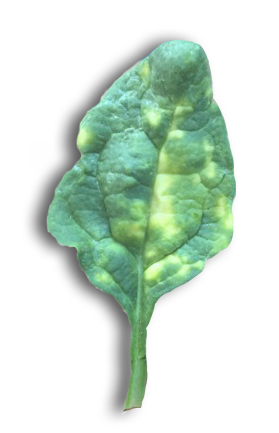
|
|
|
|

|
|||
|
|
|||
|
|
|||
Downy mildew is a disease of several crops grown in the desert southwest, including lettuce, spinach, onions, and cruciferous crops. Even though different but closely related pathogens cause the disease on each of these crops, disease intensity on all crops tends to vary in unison from year to year. For example, downy mildew severity in general was especially severe during the 2014-15 and 2016-17 growing seasons compared to 2015-16 and 2017-18. Why the difference in disease severity from year to year? Development of downy mildew and the activity of the causal pathogens of the disease are known to be stimulated by the presence of water. One’s first thought might be that the amount of rainfall could be used to predict potential downy mildew epidemics. Rainfall is important, but the critical factors affecting downy mildew development are the number of hours during the late evening and morning that leaves are wet as well as the number of days that these leaf wetness conditions occur. During leaf wetness periods, the downy mildew pathogens produce and release spores, which when landing on healthy plant tissue germinate and cause new infections. So, it is the duration of plant wetness and not just rainfall itself that drives downy mildew epidemics. To illustrate, let’s examine the number of nights when relative humidity was at or above 90% (a level at which dew formation would be expected), as recorded at three AZMET weather stations (Yuma Valley, N. Gila Valley, and Roll). For growing seasons where downy mildew was generally severe, the average number of dew formation nights from October through February was 55 and 56 for 2014-15 and 2016-17, respectively. On the other hand, when downy mildew was less severe, the number of dew formation nights during the same time period was 30 and 15 for the respective 2015-16 and 2017-18 seasons. Additional factors, such as microclimate effects, low wind, and sprinkler irrigation, also can affect dew formation and duration, which in turn influences downy mildew development and severity. |
|||
| Back | |||
|
For questions or comments on any of the topics please contact Marco Pena at the Yuma Agricultural Center.
|
|||
|
Home |
Cotton | Veggies |
Forages | Grains
| Citrus |
Crop x Crop Insects | Diseases| Weeds | Pesticides | Economics | News | Weather | Research | Photos | Contacts | General Info. Copyright © 2001 University of Arizona, College of Agriculture and Life Sciences Webmaster: Al Fournier (acis@ag.arizona.edu) |
|||

